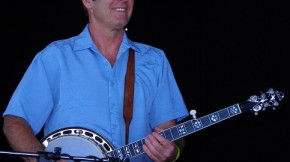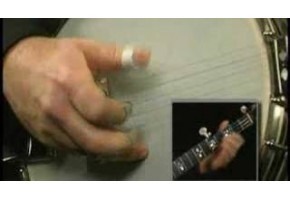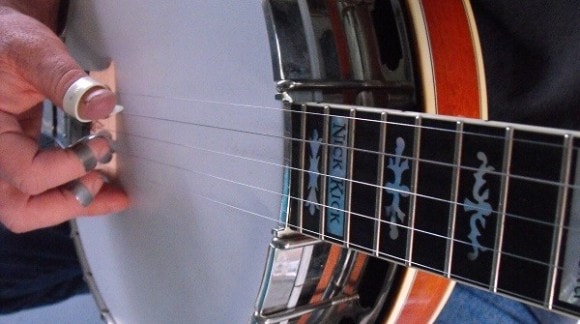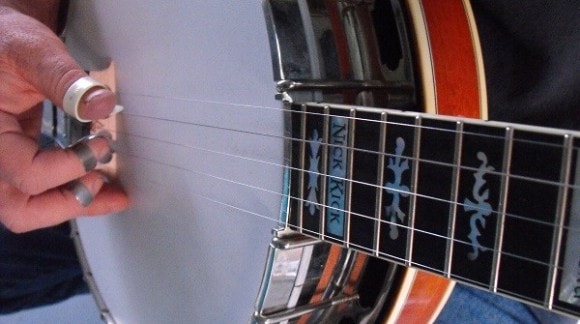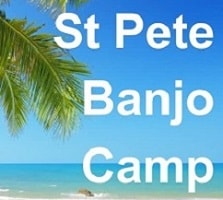Glossary of Common Banjo Words and Phrases by Ross Nickerson
Banjo Glossary by Ross Nickerson
Definitions of the most common words associated with playing and learning how to play the banjo
The definitions are listed alphabetically and cover many different abbreviations, acronyms, expressions, slang and technical terms used when describing the many things involved with playing the banjo. This is an excerpt from Ross Nickerson's The Banjo Encyclopedia, "Bluegrass Banjo from A to Z"
Accent - refers to picking a note with emphasis.
Arpeggio - An arpeggio is a method of playing the individual notes in a chord. Rather than playing all of the notes simultaneously. In other words, picking each individual note of the chord one at a time rather than strumming the chord.
Backup - used to describe a style of banjo playing that supports other instruments or singers.
Barre Chord or Barre Chord Form - a chord form that normally covers three or more strings on the same fret and can be used to play different major chords on the neck by simply moving that position from fret to fret.
Bass Runs - notes that are normally played on the 4th string that lead into a chord or solo.
Binding - a strip made of a plastic composite material that goes along the top of the fingerboard. It usually has dots that indicate the 3rd, 5th, 7th, 10th, 12th, 15th, 17th, and 19th frets.
Break - a slang term for solo.
Breakdown - normally refers to a fast bluegrass instrumental.
Bridge - the strings vibrating on the wooden bridge and then vibrating on the banjo head transfer the tone to the banjo. Therefore, you should choose your bridge carefully. They are normally made of maple with an ebony top.
C Tuning - lowering the 4th string to C from standard G tuning.
Capo - a clamp-like device used for changing keys by raising the pitch of all your strings together. It allows you to play in the same way as you would in open G tuning.
Capo Spikes - these 5th string capo spikes are actually HO model railroad spikes. I’m not sure who thought of this first but it was brilliant. They are inserted into the fret board and are used for capoing the fifth string.
Chops - a term used to describe a musician’s ability. “He has a lot of chops.”
Chord Forms - the actual shape your left hand is making on the fret board. Normally associated with chord positions that are movable.
Chord Inversions - using different chord shapes in different places on the fret board to play the same chord or notes.Chord Progression - a series of chords that make up a song.
Chord Structure - how the chords, in total, are put together to form a particular song.
Chromatic - playing each note in succession without skipping any frets. The chromatic scale is all twelve notes of the octave including all flats and sharps. Chromatic style in bluegrass banjo playing is similar to melodic style and is used often for “flashy” or “hot licks.”
Clawhammer Style - a style that is similar to frailing (see frailing definition). However, in Clawhammer Style, the thumb plays the melody notes more often and plays more of a role than in frailing. This style is used to play more intricate melodies, while the frailing style is based more on rhythm.
Crash and Burn - a slang used for making a mistake in a song that is very obvious or blowing an ending.
Down the Neck - usually refers to playing at or below the 5th fret.
D Position - a chord form that can be used to play different major chords on the neck by simply moving that position from fret to fret.
D Tuner - a device used to tune a string for a musical effect during a song or to quickly get from G to D tuning. Often called Scruggs Tuners or Keith pegs.
Down Cold - knowing a song so well that you can play it effortlessly in front of an audience or even your banjo teacher.
Embellish - to add something to the music that you are playing. For instance, embellishing a B note by sliding up to the note and striking the string with emphasis.
Frailing - a style of banjo playing that uses a strumming technique that catches the 5th string with the thumb and strikes down with the back of index or middle fingernail to play melody notes. It produces a bump ditty sound. Sometimes referred to as Old Time Banjo playing.
Flat - a musical term often used to describe lowering a pitch one half step or fret. When tuning, if the pitch is flat, it is too low, if the pitch sharp, it is too high.
Fret Board or Fingerboard - refers to the surface of the banjo neck where you place your fingers when fretting the strings.
F Position - a chord form that can be used to play different major chords on the neck by simply moving that position from fret to fret.
G Tuning - the tuning that is used most often for bluegrass banjo playing.
Half Step - raising or lowering a note one fret.
Hot Lick - used to describe a lick that is flashy and stands out.
Improvising - deviating from a particular way of playing a song or melody and creating your own solo or interpretation within that song.
Instrumental - used to describe a song with no words or singing.
Intro - describes the beginning of a song or the beginning of a section of a song. The banjo often plays the intro before anyone else joins in.
Keith Style - often used to describe Melodic Style. Bill Keith was instrumental in developing and popularizing the Melodic Style.
Key - a key can be described as major or minor. It defines the relationship of notes within a common center, tonic, or root note, (the root note is the note for which the key is named).
Lead-ins - these are normally notes played at the beginning of a song that “lead-in” to the song. Often, they are played before the rest of the band joins in.
Lick - a word used to describe a short phrase of music played that can be used in a variety of musical situations.
Measure - a measure in written music is used to measure a unit of time. A measure in 4/4 time consists of four quarter beats within that measure. There are three quarter beats in a measure of 3/4 time.
Melodic Style - a term used to describe a method of banjo playing that plays all or most of the melody notes of the tune, much like a fiddle.
Metronome - a device used that measures time by beats per minute. The metronome clicks and flashes a light for every beat and is used to help the student play in time.
Move - used to describe moving from one spot to another on the fingerboard. “That was a difficult move.” “This move will take practice.”
Mute - a banjo mute usually attaches to the bridge and is used to dampen the sound of the banjo by impeding the vibration of the bridge. These can be handy for students with spouses who have a low tolerance for practicing.
Nut - the bone or plastic piece at the end of the fretboard that the strings fit through.
Octave - the distance between the same note seven diatonic pitches apart; the lower note vibrates half as fast as the upper and sounds an octave lower.
Open G - used to describe G tuning, which is considered standard tuning for bluegrass banjo playing.. Also describes the banjo when the open strings are tuned to a G chord.
Passing Tones - notes or tones that work well in transition between other notes. Passing tones are used often to describe notes played between chord changes, especially when playing backup.
Pick up Notes - sometimes called intro notes or lead-ins (see definition for lead-in notes). They are usually a short phrase of notes that cue other band members or the listener that a section of a song is beginning.
Pinch - plucking two or more strings together at the same time with more than one finger.
Pitch - highness or lowness of a tone, depending on the frequency (rate of vibration).
Pegs - simply refers to the tuning pegs on the banjo.
Plectrum Banjo - a banjo that has four strings and is the same scale length as a five-string bluegrass banjo. It is normally tuned to C tuning and is played with a flat pick.
Pot - refers to the wood rim and tone ring of a Mastertone Style Banjo.
Reno Style - this name credits banjo player Don Reno and normally refers to the single-string technique or other original techniques of his.
Rhythm Tracks - a term used to describe recorded music that is a rhythm section that you can play along with for practice. It normally has no other banjo playing or other lead instruments.
Rim - the banjo tone chamber or pot in a standard Mastertone Style Banjo that has a wood rim (normally 3-ply maple) and a bell bronze tone ring fitted on top of it.
Roll - a pattern of notes, normally one measure long consisting of quarter and eighth notes that is used to create and perform banjo songs.
Scale - a series of notes or pitches in an ascending or descending order. The notes in the scale are often assigned numbers (1-8) or syllables (do-re-mi-fa-so-la-ti-do).
Scruggs Style - a style named after banjo player Earl Scruggs. Earl Scruggs perfected and popularized a style of banjo playing using three fingers. Much of bluegrass banjo playing is derived from the Scruggs’ Style.
Scruggs Tuners - a device used to tune a string for a musical effect during a song or to quickly get from G to D tuning. Sometimes referred to as D tuners or Keith pegs.
Sharp - a musical term often used to describe raising a pitch one half step or fret. When tuning, if the note is sharp, the pitch is too high, and if the note is flat, the pitch is to low.
Single-String Style - a technique of banjo playing that involves playing notes one at a time on the same string rather than within a roll as in the three-finger style. The technique in the right hand uses a down stroke of the thumb and an upstroke of the index. This simulates the up and down motion of a flatpick used when playing the guitar or mandolin.
Solo - a section of a song that features a particular person or instrument.
Slur - a musical term used for altering a note by slurring it to another note. An example of a slur in banjo playing could be a slide, pull-off, hammer-on, or choke.
Staff - these are the lines on which music is written. There are five lines in a standard music staff and also five lines used in banjo tablature.
Stanley Style - a style of banjo playing named after banjo founding father, Ralph Stanley. It favors a forward roll and playing the melody often with the index finger.
Tag Lick - a phrase of music used to complete a verse, chorus, or section of an instrumental.
Tempo - the speed at which a song is played.
Tenor Banjo - a four-string banjo that has four strings and is shorter in length by three frets than a standard five-string banjo. It is played with a flat pick and is normally associated with Dixieland Music.
Third or Thirds - the interval or distance between two notes that are two diatonic scale steps apart. For instance, playing a C and an E note together would be playing a third. The notes G, B and D are a third apart.
Three-Finger Style - describes the technique used in bluegrass banjo playing. Sometimes called Scruggs’ Style or visa versa.
Tone - this term is often used in bluegrass banjo playing to describe the overall quality of sound produced by a banjo.
Tone Ring - is probably the most important component to the banjo’s overall sound. A good quality tone ring is made of bell bronze and is the heaviest part of the banjo. It is fitted on top of a wood rim, and then the head is tightened down on top of the tone ring by twenty-four brackets pulling the tension hoop down.
Turnaround - used to describe transitioning from the end of the verse, chorus, or section of a song to the beginning of the next verse, chorus, or section of the song.
Up Tempo - a fast song. Upping the tempo is increasing the speed of a song.
Up the neck - refers to playing the banjo above the 5th fret.
Walk-downs - leading or passing tones that “walk down” to a lower pitch.
Whole step - used to describe two notes a whole tone apart, or two half steps. Practically speaking, two frets apart on the fingerboard.
Vamping - a term used in bluegrass banjo playing for muting the chords with the left hand after pinching the strings with the right hand, usually when playing backup.
Verse - a group of lyrics normally sung solo. The verse is usually one time through the basic chord progression of the song.


